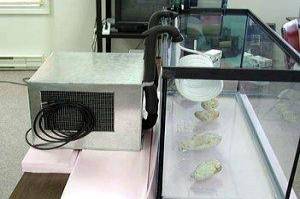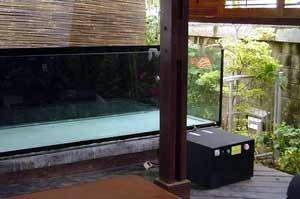Comprehensive Guide to Aquarium Chillers: Benefits, Drawbacks, and Essential Tips


Source of images: asf.ca
Quick Links - Your Questions Answered
Brief Overview
Aquarium chillers are essential equipment for many aquarists, particularly those keeping marine fish or living in warmer climates. While not every tank setup requires a chiller, they play a crucial role in maintaining a consistent water temperature, especially during hot summer months. Understanding how chillers work, their pros and cons, and how to properly maintain them can help you decide if one is right for your aquarium.
How Do Aquarium Chillers Work?
An aquarium chiller functions similarly to a refrigerator. It contains refrigeration gases that compress and expand to regulate temperature. Here's a simplified explanation of how they operate:
Inside the chiller, a probe is placed in the aquarium water. This probe cools the water to a specific temperature, which you set on the chiller's control unit. Some models work by being plumbed in-line with the hoses of the aquarium filter, while others use an internal probe to directly monitor and adjust the water's temperature.
When the refrigeration gases inside the chiller compress, they generate heat. This heat is then expelled into the surrounding air by built-in fans. After the heat is released, the gases expand through a valve, cooling them down. The cooled gas passes through the probe or coils, lowering the water temperature as the water circulates around them.
Chillers come in different sizes and capacities, rated by the volume of water they can cool effectively. It's crucial to choose a chiller that matches your tank size; using an undersized chiller might result in ineffective cooling, leading to stress for your aquatic life. Additionally, make sure to place the chiller in an area with good ventilation to avoid overheating.
Comparison of Aquarium Chiller Types
Choosing the right type of chiller depends on your tank's size and cooling needs. Here is a comparison of common chiller types:
| Type of Chiller | Recommended Tank Size | Cooling Capacity | Power Consumption | Pros | Cons |
|---|---|---|---|---|---|
| In-Line Chiller | Medium to Large (50-500 gallons) | High | Moderate to High | Highly efficient, suitable for large tanks | Complex installation, requires plumbing |
| Drop-In Chiller | Large (100 gallons) | Very High | High | Easy to install, great for sumps | Bulky, not suitable for small tanks |
| Thermoelectric Chiller | Small (up to 50 gallons) | Low | Low to Moderate | Compact, ideal for nano tanks | Limited cooling capacity |
Pros and Cons of Using a Chiller
Chillers can be incredibly useful, but they also have drawbacks. Understanding both sides can help you make an informed decision.
Advantages of Aquarium Chillers
- Consistent Temperature Control: Chillers maintain a stable water temperature, which is vital for the health of many fish, especially marine species that require specific conditions. Cooler water can hold more dissolved oxygen, which is crucial for fish respiration and overall tank health.
- Reduced Stress for Fish: Stable temperatures reduce stress in fish, promoting longer, healthier lives. Consistent temperatures also prevent sudden metabolic changes, which can lead to health issues. Higher temperatures can lower the oxygen levels in the water, making it harder for fish to breathe and causing additional stress. A chiller helps keep the temperature within the optimal range, maintaining adequate oxygen levels.
- Peace of Mind: Whether you're on vacation or at work, having a chiller removes the worry about sudden temperature spikes, keeping your aquarium inhabitants safe. Lower temperatures ensure that oxygen levels remain higher, reducing the risk of hypoxia for your fish.
- Better for Sensitive Species: Some aquatic life forms, such as corals and invertebrates, are extremely sensitive to temperature changes. Chillers provide the precise control needed to keep these species thriving.
Disadvantages of Aquarium Chillers
- Initial Investment: Chillers can be expensive, with prices ranging from $100 to several thousand dollars, depending on the model and capacity. Researching your options and assessing your tank's specific needs can help you find the best value for your budget.
- Running Costs: Higher wattage chillers consume more electricity, increasing your utility bills. While smaller, lower-wattage models may seem cost-effective, they might not always be reliable for larger tanks. Always check the chiller’s power consumption and calculate potential costs before purchasing.
- Maintenance: Like any equipment, chillers require regular checks to ensure they are functioning correctly. Relying solely on a chiller without monitoring can lead to potential issues if the unit fails. Be prepared for maintenance costs, such as replacing filters and parts over time.
- Space Requirements: Chillers can take up a significant amount of space around your aquarium. Ensure that you have adequate room for both the unit and ventilation, as restricted airflow can reduce the chiller's efficiency.
Alternative Water Cooling Methods
If investing in a chiller seems too costly or unnecessary for your tank, there are alternative ways to cool your aquarium water:
- Floating Ice Bottles: Place ice in plastic bottles and float them in the tank. This method offers immediate cooling but is short-term, as melted ice will eventually cause the temperature to rise again. This process can be tedious, requiring constant attention.
- Use Electric Fans: Directing small fans over the water surface can help lower the temperature by increasing evaporation. This method, however, isn't as precise as using a chiller and may cause a rapid change in water levels due to evaporation, requiring regular top-ups.
- Turn Off Lights: Reduce the heat absorbed by the water by turning off or minimizing aquarium lighting, especially during hot days. However, this approach can disrupt the natural day-night cycle for fish and plants, potentially affecting their health.
- Adjust Room Temperature: If possible, use air conditioning or keep the room cool where the aquarium is located. While not a direct method, it helps create a more stable environment for the tank.
Case Study: Using an In-Line Chiller for a Marine Aquarium
Jane, an experienced aquarist, owns a 200-gallon reef tank filled with various corals and marine fish. During the summer months, she struggled to maintain the tank's temperature within the safe range of 24-26°C (75-79°F). After researching her options, she decided to invest in an in-line chiller.
She chose a chiller rated for 300 gallons to ensure efficient cooling. Installation involved connecting the chiller to her sump's filtration system. After setting up the unit, Jane noticed a significant improvement in her tank's temperature stability, even on the hottest days. Her corals displayed more vibrant colors, and her fish appeared less stressed. Jane now performs regular maintenance, including cleaning the chiller's filter, to keep it operating efficiently. This investment helped her avoid potential losses of her valuable marine life due to overheating.
Quick Tips for Using Aquarium Chillers
- Always choose a chiller rated for at least 1.5 times your tank's volume to ensure efficient cooling.
- Place the chiller in a well-ventilated area to prevent overheating and maximize efficiency.
- Monitor your tank's temperature daily, especially during the initial chiller setup.
- Consider using a backup power source for the chiller in case of power outages to protect sensitive species.
- Perform regular maintenance, such as cleaning the filter and checking for leaks, to prolong the chiller's lifespan.
Chiller Maintenance Tips
Proper maintenance of your aquarium chiller is essential for its longevity and effectiveness. Here are some key maintenance tips:
- Clean the Filter: Chillers have internal filters that can become clogged with debris. Regularly clean or replace these filters to ensure optimal performance. Dirty filters can cause the chiller to work harder, increasing wear and energy consumption.
- Check for Leaks: Inspect hoses and connections for leaks to prevent water damage and maintain efficient operation. Even a small leak can lead to significant water loss and damage to your equipment.
- Keep Vents Clear: Ensure the chiller’s vents are free from dust and debris to maintain proper airflow and prevent overheating. Restricted airflow can lead to reduced efficiency and potential breakdowns.
- Monitor Performance: Periodically check the water temperature and compare it with the chiller’s set point to ensure it’s working correctly. Sudden temperature changes could indicate a malfunction that needs immediate attention.
Where to Buy Chillers
Finding a reliable supplier is crucial when purchasing an aquarium chiller. Here are some trusted sources:
- jbjchillers.com - Known for high-quality in-line chillers, JBJ offers various models suitable for different tank sizes.
- aquatictech.com - Provides a range of aquarium equipment, including chillers, with knowledgeable staff for customer support.
- aquacave.com - Offers chillers from leading brands, catering to both small nano tanks and large marine setups.
- thatpetplace.com - A well-known retailer that stocks a variety of chillers and provides detailed product descriptions to help you choose the right model.
- marinedepot.com - Specializes in marine aquarium equipment and carries a selection of chillers, ideal for reef tanks.
FAQ
Below are answers to some common questions about aquarium chillers:
What is the purpose of an aquarium chiller?
An aquarium chiller’s primary function is to lower and maintain the water temperature in a tank, creating a stable environment for marine, coldwater, or temperature-sensitive species. Without a chiller, temperature fluctuations can cause stress, illness, and even death in sensitive fish and corals.
Do I need an aquarium chiller?
If you keep marine fish, coldwater species, or live in a hot climate, a chiller might be essential to prevent temperature spikes. It is particularly important for species that require temperatures below 15°C (59°F) or for reef aquariums where corals thrive only within a specific temperature range. Sudden temperature shifts can also negatively impact fish metabolism and immune systems, increasing susceptibility to diseases.
What are the costs of aquarium chillers?
Prices range from $100 for basic, small-tank models to over $1,400 for high-end, large-capacity units. Before purchasing, consider the chiller's wattage, cooling capacity, and tank compatibility. While the upfront cost may be high, investing in a quality chiller can save you money in the long run by reducing the risk of fish stress and disease.
How do I set up a chiller?
Place the chiller in an open space to allow proper ventilation, preventing overheating and ensuring efficiency. Most chillers come with specific installation instructions, so it's essential to follow the manufacturer's guidelines. In-line chillers will require connecting to the aquarium's filter system, while others may use a probe directly in the tank. Always run the chiller's hoses and cables securely to avoid leaks and accidents.
Is a chiller necessary for goldfish?
Yes, goldfish are coldwater fish and thrive in temperatures ranging from 10-20°C (50-68°F). Warmer temperatures can cause stress and shorten their lifespan. If you can't keep the tank's temperature within this range, a chiller is a worthwhile investment to keep your goldfish healthy.
How do I choose the right chiller size for my tank?
The size of the chiller depends on your tank's volume and the temperature difference you need to achieve. Check the chiller's specifications for its recommended tank size and cooling capacity (usually measured in horsepower or watts). A general rule is to choose a chiller that can handle 1-1.5 times the volume of your tank for maximum efficiency. Oversizing slightly is better than choosing an undersized unit that may struggle to maintain the desired temperature.
Can I use a chiller for a freshwater tank?
Yes, you can use a chiller for a freshwater tank, especially if you keep coldwater species or want to mimic specific natural environments, such as mountain streams or rivers. While tropical freshwater fish do not generally need chillers, certain setups, like shrimp breeding tanks or planted aquariums, may benefit from temperature control provided by a chiller.
